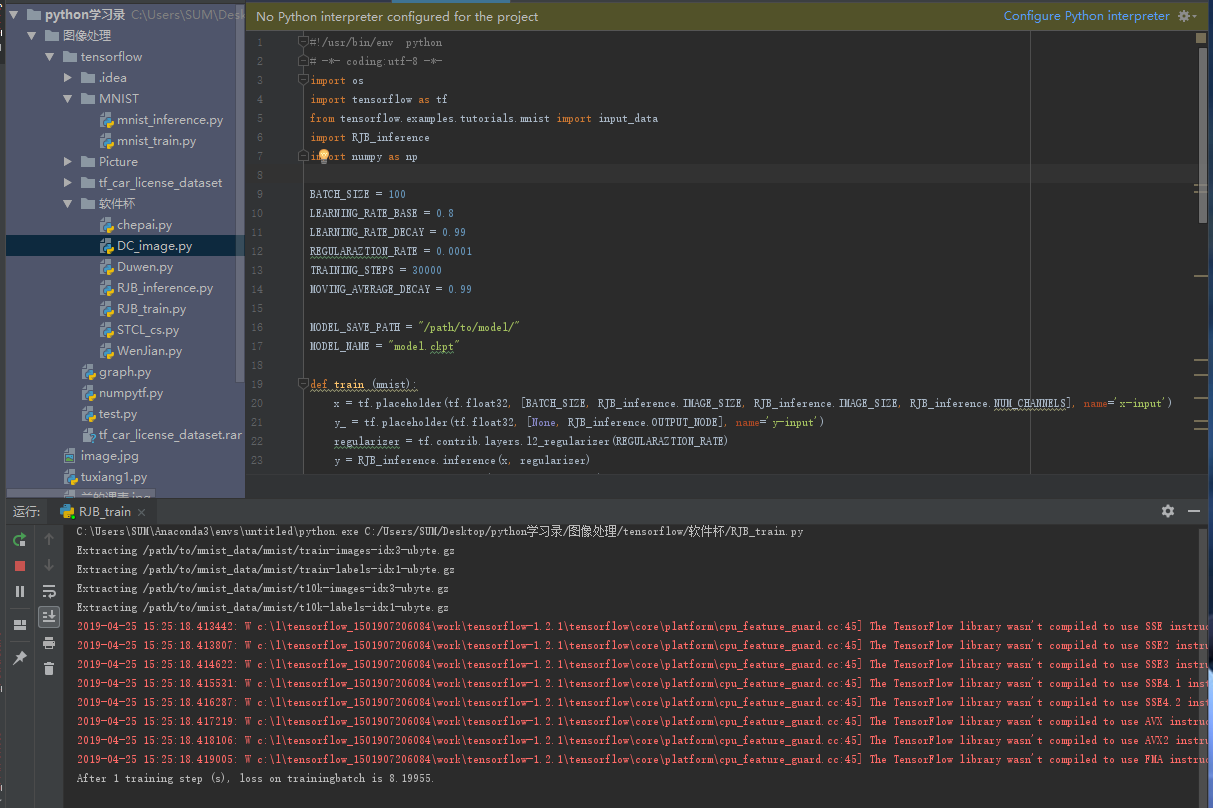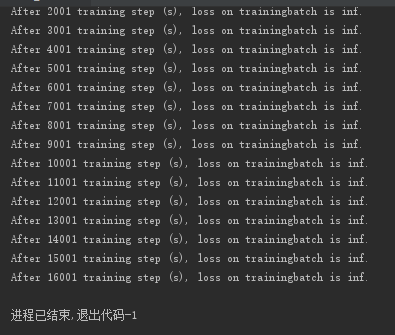今天自己闲来无事,为了验证自己这几天的学习成果。决定参考MNIST数据集的格式来搭建属于自己的卷积神经网络。下面是我自己搭建的神经网络。具体是七层结构。输入层--卷积--池化--1*1 3*3 5*5三路径卷积后链接层--1*1 及池化+1*1两路径的卷积层--全连接层--输出层。 是不是看起来很复杂,其实我也这么觉得。(所以说是随便搭撘玩玩)
直接上代码:
网络结构搭建代码:
#!/usr/bin/env python
# -*- coding:utf-8 -*-
import tensorflow as tf
#定义神经网络结构的相关参数
INPUT_NODE = 784 #图片像素矩阵的大小 根据前期的数据处理得到的图片大小的乘积来设定
OUTPUT_NODE = 10 #数字识别0-9
IMAGE_SIZE = 28 #图片的边长
NUM_CHANNELS = 1 #图片的深度1,3
NUM_LABELS = 10 #输出序列大小
#第一层卷积层尺寸和深度
CONV1_DEEP = 32
CONV1_SIZE = 5
#全连接层节点数
FC_SIZE = 512
#定义get_variable函数来获取变量
def get_weight_variable(shape, regularizer):
weights = tf.get_variable("weights", shape, initializer=tf.truncated_normal_initializer(stddev=0.1))
#当给出正则生成函数时,将当前变量的正则损失加入到名为“losses”的集合
if regularizer != None:
tf.add_to_collection('losses', regularizer(weights))
return weights
#定义神经网络前向传播过程 train用于区分训练和测试过程 使用到dropout方法可以防止过拟合
def inference(input_tensor, regularizer):
#加载slim库:可以简化cnn卷积网络的定义,使得代码更加容易阅读
slim = tf.contrib.slim
#定义一个默认参数设置列表,即列表中的函数将会默认使用后面得参数设置。步长为1,使用VALID不填充可以使得大小一致;或者步长2--,SAME填充使得结果尺寸一致
with slim.arg_scope([slim.conv2d, slim.max_pool2d, slim.avg_pool2d], stride=1, padding='SAME'):
#为每一个模块均定义一个命名空间
#首先经历一个传统定义的卷积层.输入28*28*1矩阵 过滤器5*5*32 输出结果为28*28*32 relu1
with tf.variable_scope('layer1-conv1'):
conv1_weights = tf.get_variable("weight", [CONV1_SIZE, CONV1_SIZE, NUM_CHANNELS, CONV1_DEEP], initializer=tf.truncated_normal_initializer(stddev=0.1))
conv1_biases = tf.get_variable("bias", [CONV1_DEEP], initializer=tf.constant_initializer(0.0))
conv1 = tf.nn.conv2d(input_tensor, conv1_weights, strides=[1, 1, 1, 1], padding='SAME')
relu1 = tf.nn.relu(tf.nn.bias_add(conv1, conv1_biases))
#通过一个2*2的池化层 输出结果为14*14*32 pool1
with tf.name_scope('layer2-pool1'):
pool1 = tf.nn.max_pool(relu1, ksize=[1, 2, 2, 1], strides=[1, 2, 2, 1], padding='SAME')
#通过第一个Inception部分,由三个过滤器卷积网络构成1*1 3*3 5*5,输出结果:14*14*192
with tf.variable_scope('layer3-Inception1'):
#每一个路径一个命名空间
with tf.variable_scope('Branch1_1'):
#实现一个1*1过滤器,深度为64的卷积层
branch1_1 = slim.conv2d(pool1, 64, [1, 1], scope='Conv2d_3_1_1')
with tf.variable_scope('Branch1_3'):
branch1_3 = slim.conv2d(pool1, 64, [3, 3], scope='Conv2d_3_3_3')
with tf.variable_scope('Branch1_5'):
branch1_5 = slim.conv2d(pool1, 64, [5, 5], scope='Conv2d_3_5_5')
#拼接结果矩阵
inception1 = tf.concat([branch1_1, branch1_3, branch1_5],3)
#通过第二个Inception部分,由一个1*1 一个经过2*2池化后的1*1卷积组成 输出结果为14*14*500
with tf.variable_scope('layer4-Inception2'):
with tf.variable_scope('Branch2_1'):
branch2_1 = slim.conv2d(inception1, 244, [1, 1], scope='Conv2d_4_1_1')
with tf.variable_scope('Branch2_2'):
branch2_2 = slim.max_pool2d(inception1, [2, 2], scope='Maxpool_4_2_2')
branch2_2 = slim.conv2d(branch2_2, 256, [1, 1], scope='Conv2d_pool_4_1_1')
inception2 = tf.concat([branch2_1, branch2_2], 3)
#通过一个2*2 步长为2的池化层 输出结果为7*7*500的矩阵
with tf.name_scope('layer5-pool2'):
pool2 = tf.nn.max_pool(inception2, ksize=[1, 2, 2, 1], strides=[1, 2, 2, 1], padding='SAME')
#将第五层池化输出转化为第六层全连接的输入格式--拉成一个向量,长度为乘积
pool_shape = pool2.get_shape().as_list()
nodes = pool_shape[1]*pool_shape[2]*pool_shape[3]
reshaped = tf.reshape(pool2, [pool_shape[0], nodes])
#第六层全连接层 输入24500,输出512 引入dropout
with tf.variable_scope('layer6-fc1'):
fc1_weights = tf.get_variable("weight", [nodes, FC_SIZE], initializer=tf.truncated_normal_initializer(stddev=0.1))
#权重加入正则化
if regularizer != None:
tf.add_to_collection('losses', regularizer(fc1_weights))
fc1_biases = tf.get_variable("bias", [FC_SIZE], initializer=tf.constant_initializer(0.1))
fc1 = tf.nn.relu(tf.matmul(reshaped, fc1_weights)+fc1_biases)
# if train:fc1 = tf.nn.dropout(fc1, 0.5)
#第七层Softmax分类结果层 512 -- 10
with tf.variable_scope('layer7-fc2'):
fc2_weights = get_weight_variable([FC_SIZE, NUM_LABELS], regularizer)
fc2_biases = tf.get_variable("bias", [NUM_LABELS], initializer=tf.constant_initializer(0.1))
logit = tf.matmul(fc1, fc2_weights)+fc2_biases
return logit
搭建好网络后,下面该进行网络的训练程序编辑。先用最原始的训练方式:
#!/usr/bin/env python
# -*- coding:utf-8 -*-
import os
import tensorflow as tf
from tensorflow.examples.tutorials.mnist import input_data
import RJB_inference
import numpy as np
BATCH_SIZE = 100
LEARNING_RATE_BASE = 0.8
LEARNING_RATE_DECAY = 0.99
REGULARAZTION_RATE = 0.0001
TRAINING_STEPS = 30000
MOVING_AVERAGE_DECAY = 0.99
MODEL_SAVE_PATH = "/path/to/model/"
MODEL_NAME = "model.ckpt"
def train (mnist):
x = tf.placeholder(tf.float32, [BATCH_SIZE, RJB_inference.IMAGE_SIZE, RJB_inference.IMAGE_SIZE, RJB_inference.NUM_CHANNELS], name='x-input')
y_ = tf.placeholder(tf.float32, [None, RJB_inference.OUTPUT_NODE], name='y-input')
regularizer = tf.contrib.layers.l2_regularizer(REGULARAZTION_RATE)
y = RJB_inference.inference(x, regularizer)
global_step = tf.Variable(0, trainable=False)
variable_averages = tf.train.ExponentialMovingAverage(MOVING_AVERAGE_DECAY, global_step)
variable_averages_op = variable_averages.apply(tf.trainable_variables())
cross_entropy = tf.nn.sparse_softmax_cross_entropy_with_logits(logits=y, labels=tf.argmax(y_, 1))
cross_entropy_mean = tf.reduce_mean(cross_entropy)
loss = cross_entropy_mean+tf.add_n(tf.get_collection('losses'))
learning_rate = tf.train.exponential_decay(LEARNING_RATE_BASE, global_step, mnist.train.num_examples/BATCH_SIZE, LEARNING_RATE_DECAY)
train_step = tf.train.GradientDescentOptimizer(learning_rate)\
.minimize(loss, global_step=global_step)
with tf.control_dependencies([train_step, variable_averages_op]):
train_op = tf.no_op(name='train')
saver = tf.train.Saver()
with tf.Session() as sess:
tf.global_variables_initializer().run()
for i in range(TRAINING_STEPS):
xs, ys = mnist.train.next_batch(BATCH_SIZE)
reshaped_xs = np.reshape(xs, (BATCH_SIZE, RJB_inference.IMAGE_SIZE, RJB_inference.IMAGE_SIZE, RJB_inference.NUM_CHANNELS))
_, loss_value, step = sess.run([train_op, loss, global_step], feed_dict={x: reshaped_xs, y_: ys})
if i%1000 == 0:
print("After %d training step (s), loss on training""batch is %g." % (step, loss_value))
saver.save(sess, os.path.join(MODEL_SAVE_PATH, MODEL_NAME), global_step=global_step)
def main(argv=None):
mnist = input_data.read_data_sets("/path/to/mnist_data/mnist/", one_hot=True)
train(mnist)
if __name__=='__main__':
tf.app.run()
其中值得注意的是,如果报了一下的错误:

是因为连接函数concat()的参数定义顺序出了问题。查了一下,说是自1.0版本以后的Tensorflow,该函数的参数顺序就发生了改变,【】在前而数字在后。
改正错误之后就可以顺利运行了,注意必须下载MNIST的数据集,并改下程序里相应的路径就可以了。最后逇运行效果如下:

可以看出程序已经开始迭代训练了,不过似乎速度有点慢。因为网络结构搭建的过于复杂。
 %
%
%%%等了很久,最后的结果很不满意:。而且似乎还有问题。在后面的博客中我将就此问题作出解决,同时尝试Gpu的编程使得网络的训练速度加快。或者简化网络的结构提高运算速度。





















 507
507

 被折叠的 条评论
为什么被折叠?
被折叠的 条评论
为什么被折叠?








